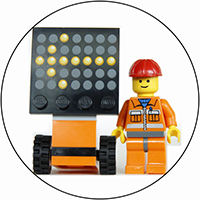While there is anecdotal information that using educational technologies for health and safety training is on the rise, what is evident is that there are major trends that are emerging with developers and providers of health and safety training that make use of educational technologies.
Using Data to Focus Training
One of the ways that technology is being used in the development of vocational training is the focusing of training through data collection and analysis. Teizer, Cheng and Fang (2013) focused on tracking the movements of ironworkers erecting a building in order to identify areas of hazards, hazardous practices, and areas to improve productivity. As training has already been proven to reduce injuries and costs, an integrated training system can further reduce costs and injuries by providing real-time feedback and post analysis during instructional sessions.
In their study, workers, who were apprentices, were tracked in real time and the data collected was used to evaluate proximity hazard location. Immediate concerns were reported to the work crew and safety supervisors while others were tracked to identify patterns in the data set. Also tracked were positive behaviours to be noted and shown in the post analysis sessions. These data sets were then used to construct 3-D environments with multiple viewpoints for use in classroom training sessions. As a result, the common hazards or incidents could be visualized and training could be focused.
Using Technology to Engage Learners
The practical nature of the work in many vocations sometimes presents a challenge when developing and delivering training on health and safety, in that many of the skills needed are of a practical hands-on nature. In addition, many of the individuals employed in such areas learn better with hands-on learning tools. In some instances that may involve large machinery or harmful substances, it can be dangerous to train for health and safety in a practical situation. Through creating virtual environments there is a blend of offering the hands-on practical training, and providing a technology solution that can be accessed from anywhere at any time.
Nakayama and Jin (2015) conducted a pilot study project where a virtual 3-D environment was constructed to teach the safe operation of a pedestal grinder. They chose this particular task after speaking with industry professionals and reviewing the most-cited occupational health and safety violations. The study used three different groups of students: lecture only, lecture with a practical component and lecture with the virtual exercise. The results indicated that the group with the virtual exercise possessed the same safety knowledge as the group that received the practical experience. In both cases, the students showed a greater understanding than the students in the lecture only group.
There are also examples of a blended learning approach making and impact on user engagement. In his article “A blended learning approach to safety training: Student experiences of safe work practices and safety culture,” Stuart (2013) examines how a blended learning approach can influence a safety culture among students taking a degree in Timber Product Technology, focusing on the furniture manufacturing industry, specifically the Irish furniture manufacturing industry, and the training program at the Dublin Institute of Technology.

